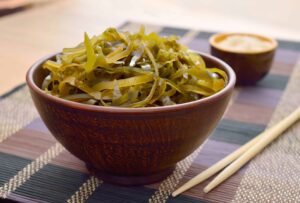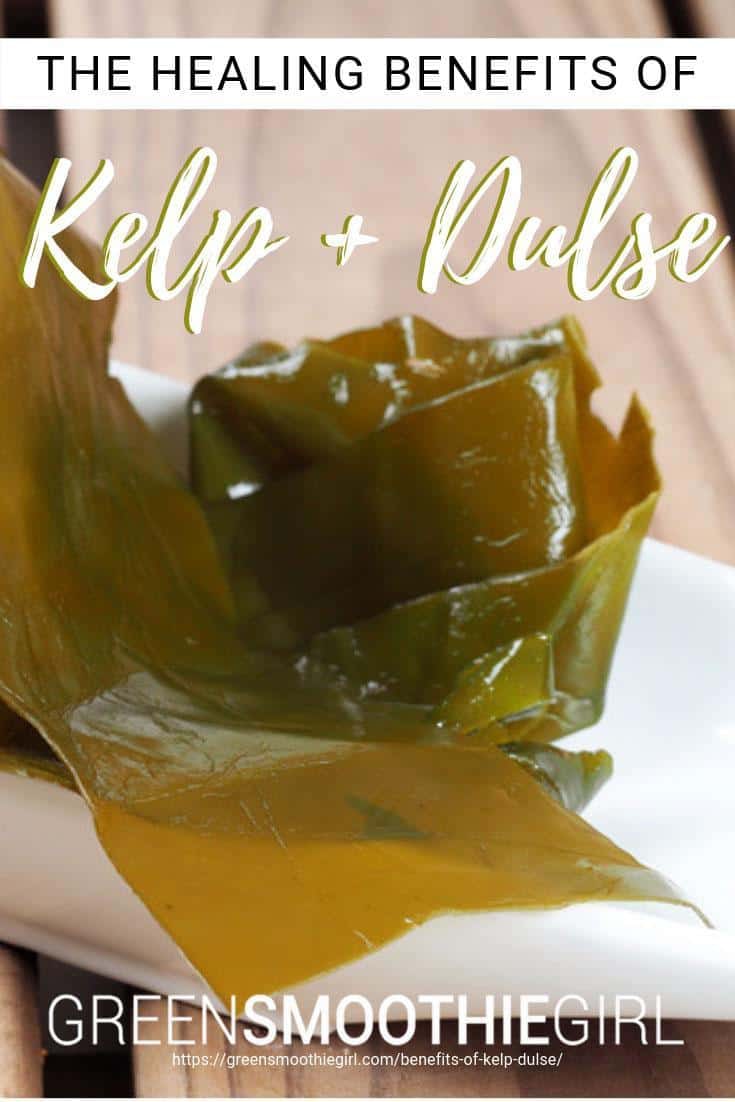Health Benefits of Kelp and Dulse (And How To Eat It)

You’re probably familiar with kelp—the green-brown seaweed that creates the beautiful kelp forests along the shores of the Pacific Ocean and is known for its astronomical growth rates. You may, however, not be as familiar with dulse, its red-bladed counterpart that dwells off the North Atlantic coasts of America as well as many parts of Europe.
Kelp and dulse are both considered superfoods of the oceans, packed with vitamins, minerals, protein, antioxidants, and compounds that have been shown to provide incredible health benefits.
Let’s take a closer look at what makes these types of seaweeds unique, why they’re an important addition to a healthy diet, and how easy they are to include in your daily green smoothie.
In this article:
- The History of Kelp and Dulse as Part of a Healthy Diet
- The Health Benefits of Kelp and Dulse
- How to Eat Kelp and Dulse in Your Diet
- Kelp and Dulse in Smoothies
The History of Kelp and Dulse as Part of a Healthy Diet
These seaweeds have been used for thousands of years, both as food and medicine. The Chinese have been eating kelp since at least the 5th century. The ancient Hawaiians grew kelp for food, medicine, and for use in ceremonies. St. Columba’s monks, living on an island off the west coast of Scotland, recorded using dulse some 1400 years ago, and it is currently a common snack food in Ireland as well as Iceland.1

If you think kelp is just another fad food, think again! The health benefits of kelp have been documented for centuries.
Kombu, a native kelp from Japan, has been an indispensable part of the Japanese diet for over 2,000 years, and may very well be one of the reasons the Japanese people have one of the longest life expectancies in the world!
Americans, unfortunately, have been a little slower to embrace seaweed as a food staple. That may be changing as people turn to healthier lifestyles. Seaweed has been called the “new kale” and is one of the most sustainable foods on the planet.
The Health Benefits of Kelp and Dulse
Unlike plants that grow in soil that is often depleted of essential minerals, the ocean is mineral-rich and constantly replenishes the micronutrients that are found in these nutritious seaweeds. Because of this environment, kelp and dulse are rich in minerals such as calcium, magnesium, potassium, copper, iron, and the trace element iodine. They also contain an abundance of vitamins such as vitamins A, C, D, E, K, and most of the B vitamins including riboflavin, niacin, B-6 and B-12.
In fact, no land plant contains as many essential minerals as seaweed!
Many of these trace elements and minerals are in chelated form, meaning that they are bioavailable, easily assimilated and used by our bodies.
Some of their greatest health benefits, however, come from the vast array of phytochemicals, antioxidants, omega-3 fatty acids, and fiber.
Here are some of the many remarkable benefits of kelp and dulse:
1. Helps Regulate Thyroid Hormones
Iodine, an element abundant in kelp and dulse, is necessary for the production of thyroid hormones. These hormones control your metabolism and regulate several vital body functions including heart rate, body weight, menstrual cycles, body temperature, and cholesterol levels. Once leaving the thyroid, they travel through your bloodstream in order to reach almost every cell in the body.
If you are deficient in these important hormones, you may exhibit the following symptoms: fatigue, dry skin and hair, depression, insomnia, joint and muscle pain, heavy periods, weight gain, and sensitivity to the cold.
Known as hypothyroidism, this disease affects more women than men at a ratio of 9:1. This is because estrogen, the female sex hormone, inhibits the absorption of iodine.
These hormones also promote proper bone and brain development during pregnancy and infancy, making iodine a crucial element for pregnant and lactating women. Insufficient iodine during pregnancy can ultimately affect the muscles, heart, liver, kidneys, and brain of the developing child.
Here’s the good news: kelp contains an incredible amount of iodine. In fact, it contains more iodine than just about any other food on the planet! While amounts differ depending on the environment it grows in, the species, and the manufacturer, just 1/16 of a teaspoon of quality dried kelp can provide all the iodine you need, and then some.
While dulse is a strong contender, it has just about 1/5 of the amount of iodine found in kelp. It does, however, have something else going for it—higher levels of manganese, a mineral that promotes the absorption of iodine.
In the mid-1900s, iodine deficiency developed in the interior of China due to agriculture practices. This, in turn, resulted in tens of millions of people who had some form of stunted physical and mental growth. It is a condition once known as cretinism (now called congenital iodine deficiency syndrome) and is due to low iodine supplies in the mother during pregnancy.
In response to this crisis, the Chinese developed warm-water kelp varieties which entire villages now grow and cultivate. These operations produce 650,000 metric tons of seaweed every year—enough to provide dietary iodine for 1.5 billion people.2

Thyroid issues are common, but kelp can help.
Keep in mind, you can consume too much of a good thing. While excess iodine consumption is well-tolerated in most people, consuming too much iodine can lead to hyperthyroidism in those who are susceptible. This excess can lead to one or a few of the following symptoms: anxiety, sweating, hair loss, trembling, irritability, and light menstrual periods.
2. Supports Weight Loss
Another benefit that comes from the fibers found in seaweed is that they reduce fat digestion and absorption. Researchers from Newcastle University in England found that kelp reduced fat absorption by more than 75%—more than most anti-obesity drugs on the market today!9
In a study conducted in Japan, mice fed fucoxanthin, a carotenoid found in seaweed, lost weight as well as abdominal fat.10
In addition to reducing the fat your body absorbs, fiber also makes you feel full, making both kelp and dulse remarkable contributors to weight loss.
According to research conducted at the University of Massachusetts Medical School, participants who ate 30 grams of fiber each day lost weight, lowered their blood pressure, and controlled their insulin levels—a marker for diabetes.11
3. Supports Bone Density
Did you know that kelp and dulse have more protein than meat and are a much better source of calcium than milk? (I never recommend milk as a source of calcium due to an assortment of detrimental health effects, but that’s for another blog).
In fact, kelp and dulse are among the few plants that offer a complete protein source—meaning they have all of the nine essential amino acids necessary for our bodies to function. This benefit is important for everyone, but particularly for vegetarians who can find themselves low in the amino acids lysine and methionine if they are not combining their proteins properly.

Among the many health benefits of kelp is the ability to strengthen bones.
Among sea vegetables, dulse tends to contain the highest protein content—somewhere between 9 and 25 percent, depending on the season and location.³ At the high end, this represents about half of the daily dose of protein recommended by the FDA.
Most people think about muscle tissue when they think of protein, but protein makes up over 30 percent of our bone mass! The amino acids in protein serve as building blocks for bone, but they also need to work together with calcium, vitamins D and K, and additional minerals to create strong and healthy bones.
If you eat an excess of protein and fail to incorporate these other nutrients, bone loss can occur.
In addition to protein, kelp and dulse are high in several of the nutrients proven to support bone health. These include calcium, magnesium, phosphorus, potassium, and vitamins K and D.
Researchers from Taiwan reported a reduction in age-related bone loss with the use of fucoidan, a compound found in kelp and dulse.4
4. Reduces Inflammation
Inflammation is at the root of most disease. Kelp and dulse contain high levels of antioxidants—compounds that fight disease-causing free radicals, aid people with diabetes, and act as anti-inflammatory agents.
One of the antioxidants they contain is fucoxanthin—a carotenoid found in kelp at levels that has almost 14 times the antioxidant capacity as Vitamin E.5
After researchers studied the antioxidant and anti-inflammatory properties of kelp growing off the Mediterranean coast, they concluded that kelp “exhibited significant radical scavenging activity…and significant anti-inflammatory activity.”6
5. Reduces Cholesterol, High Blood Pressure, and Arteriosclerosis
Markers of cardiovascular disease (CVD) include high blood pressure, cholesterol, and vascular inflammation. Cardiovascular disease is currently the number one cause of death around the world. Those that do survive this disease are often left with lifelong side-effects from debilitating strokes and heart disease.
The good news is that these diseases are due, in large part, to lifestyle choices such as an unhealthy diet, limited physical exercise, smoking, and an over-indulgence in alcohol. Every day, we can make a different choice.

Lifestyle choices, like exercise level and smoking habits, can make all the difference in levels of blood pressure and cholesterol.
One of the main plant-based foods now in the spotlight for decreasing the risk of CVD is (you guessed it!) seaweed. The Japanese not only have the longest life expectancies; they also have the lowest rates of CVD.
Part of this benefit comes from seaweed’s high fiber content—more than most fruits and vegetables. In kelp, it is called alginate, and in dulse it is known as carrageenan and agar.
Due to seaweed’s many antioxidants, nutritional elements, fiber content, and fatty acid profile, a review published in Phycologia concluded that food manufacturers should consider including varieties like dulse and kelp in order to reduce the risk of CVD.7
In addition to preventing CVD, this special fiber also helps prevent colon cancer, type 2 diabetes, and obesity.8
6. Improves the Symptoms of ADHD
All of our cells require potassium to function and survive, including our nerves and muscles. Dr. Ryan Drum, botanist and NATO scholar, believes that seaweed’s high potassium content may be one of the reasons that he has noted significant improvement in behavior and mental functioning when those diagnosed with ADHD added seaweed to their diets in place of Ritalin.2
Although low in fat, kelp and dulse are rich in omega-3 fatty acids as well as alpha linolenic acid. These have been shown to improve the symptoms of ADHD including behavior, cognitive skills, and focus.12
Dr. Drum also chocks up potassium to the improvement he has seen in those with fibromyalgia when seaweed was added to their diet.
7. Promotes Intestinal Health
I’ve talked about the importance of your gut as it relates to your health, energy, and happiness. Not only do the microbes found within your gut affect your digestion, metabolism and immune system; they also produce the neurotransmitters that regulate your mood, including serotonin, dopamine and GABA.
You can foster a healthy gut environment filled with “good” bacteria by your choices in food and drink. Probiotics are the bacteria and yeast that are beneficial, while prebiotics are the food these bacteria thrive on.
Kelp and dulse both have sulfated polysaccharides, sugars that are found to increase the growth of the good bacteria essential to gut health.13
8. Combats Tumors
Japan and China have used seaweed as medicine for thousands of years. Their high consumption of kelp (25 time higher than Americans) has been associated with their reduced rates of both breast and prostate cancers.14
Kelp’s anti-cancer properties are due, in part, to fucoxanthin and fucoidan, compounds that have been studied extensively and have been reported to inhibit the growth, invasion, and metastasis of cancer cells.15
Dr Jane Teas, one of the top researchers of seaweed in the world, has published studies confirming that kelp consumption in Japanese women may very well explain their lower rate of breast cancer after menopause.
[Related: 6 Things Every Woman Should Know About Breast Cancer]
9. Reduces Heavy Metals and Radioactivity
In the 1940s, Japanese physician Dr. Akizuki and his patients were less than one mile from the blast site where the atom bomb was dropped in Nagasaki. At the time, they were on a strict macrobiotic diet that consisted of seaweed, miso, and brown rice. While many others in the area did not survive the fallout, the doctor and his patients lived into old age.17
One of the many compounds found in kelp and dulse that may explain this outcome and their ability to reduce heavy metals is sodium alginate. It acts as a chelator, binding with heavy metals and removing them from the bloodstream. The National Institutes of Health reported that sodium alginate is capable of reducing the absorption of the metal strontium.17
Dioxins and PCBs are environmental toxins found throughout the world. They are released into the air from combustion processes and are extremely toxic. These toxins are readily absorbed by our bodies and stored in our fat tissues and liver. Once absorbed, they are difficult to expel. A study conducted at the Fukuoka Institute of Health and Environmental Sciences revealed that brown seaweed (kelp) accelerated the excretion of stored dioxin.18
When excreting heavy metals and other toxins, be sure to follow a detox program, drink clean water daily, and make time for infrared saunas followed by dry skin brushing.
10. Supports Beautiful Skin
A person’s health is readily observed in their hair and skin. Those pesky free radicals mentioned earlier are major contributors to aging skin and wrinkles.

One of the health benefits of kelp is its ability to combat free radicals, leading to healthier skin and hair.
Besides providing protection from free radicals, kelp has also been shown to inhibit hyaluronidase—the enzyme that breaks down the hyaluronic acid that supports our elastin and collagen fibers.
Kelp also contains sulphated pilyfucose, which has been shown to protect the skin from the harmful UV rays of the sun.
How to Eat Kelp and Dulse in Your Diet
Dr. Ryan Drum, an expert in using dietary seaweeds, recommends eating a small amount of raw seaweed every day. The body may, in some cases, take up to 4 months to develop the intestinal flora necessary to thoroughly digest and use the nutrients seaweed provides.
For many, the taste and texture of this sometimes slimy sea vegetable makes it difficult to eat in its raw state. Like most manufactured food, many of the seafood products you’ll find on grocery shelves are fibrous sheets with artificial flavors tossed in. And, while I always recommend whole food in its natural form, fresh sea veggies are not always easy to come by.
Fortunately, there are many dried varieties that have been sustainably harvested. Make sure that the label reads pure kelp and dulse and nothing else.

Dried kelp makes it easy to enjoy plenty of health benefits as part of your daily diet.
Kelp and Dulse in Smoothies
One of the best ways to add kelp or dulse to your diet is by putting it into your daily green smoothie. Kelp powder and dulse flakes are easy to incorporate. Start with about ½ tsp per serving so as not to derail the taste of your delicious smoothie. This amount depends on the manufacturer, so be sure to follow the suggested serving size.
If you can find whole dulse or kelp in your area, you can also just tear off a small piece and put it in the blender as you would your other greens. If using dried strands, soak them in water for a bit to rehydrate before adding them to your green smoothie.
When making your selection, choose organic varieties from companies that test for contaminants. Then, add them to your daily smoothie and enjoy all the incredible health benefits these beauties from the sea provide.
READ NEXT: 10 Easy Green Smoothies Kids (Of All Ages) Will Love

Disclosure: This post may contain affiliate links that help support the GSG mission without costing you extra. I recommend only companies and products that I use myself.
Resources
1. Dulse. Irish Seaweeds. https://www.irishseaweeds.com/dulse-palmaria-palmata/
2. Drum, Ryan. Medicinal Uses of Seaweeds. Island Herbs. https://naturespiritherbs.com/medicinal-uses-of-seaweeds/
3. Seaweed: An alternative protein source. Science Daily. 10/2012. https://www.sciencedaily.com/releases/2012/10/121012074659.htm
4. Hwang, PA et al. The in vitro and in vivo effects of the low molecular weigh fucoidan on the bone osteogenic differentiation properties. Cytotechnology. 08/2016. https://www.ncbi.nlm.nih.gov/pubmed/26271462
5. Mikami, Koji et al. Biosynthetic pathway and health benefits of fucoxanthin, an algae-specific xanthophyll in brown seaweeds. International Journal of Molecular Sciences. 07/2013. https://www.ncbi.nlm.nih.gov/pmc/articles/PMC3742216/
6. Mhadhebi, Lamia et al. Antioxidant, Anti-inflammatory and Antiproliferative Effects of Aqueous Extract of Three Mediterranean Brown Seaweeds of the Genus Cystoseira. Iranian Journal of Pharmaceutical Research. 01/2014. https://www.ncbi.nlm.nih.gov/pmc/articles/PMC3985253/
7. Cornish, Lynn et al. A role for dietary macroalgae in the amelioration of certain risk factors associated with cardiovascular disease. Phycologia. 06/2015. https://www.phycologia.org/doi/abs/10.2216/15-77.1?code=iphy-site&journalCode=phya
8. Cardoso, Susana et al. Seaweeds as preventive agents for cardiovascular diseases: from nutrients to functional foods. Marine Drugs. 11/2015. https://www.ncbi.nlm.nih.gov/pmc/articles/PMC4663556/
9. Seaweed to tackle rising tide of obesity. Science Daily. 03/2010. https://www.sciencedaily.com/releases/2010/03/100321203508.htm
10. Maeda, H. et al. Fucoxanthin from edible seaweed, Undaria Pinnatifida, shows anti-obesity effect through UCP1 expression in white adipose tissues. Biochemical and Biophysical Research Communications. 07/2005. https://www.ncbi.nlm.nih.gov/pubmed/15896707
11. Ferrari, Nancy. Making one change—getting more fiber—can help with weight loss. Harvard Health Publishing. 02/2015. https://www.health.harvard.edu/blog/making-one-change-getting-fiber-can-help-weight-loss-201502177721
12. Derbyshire, E. Do Omega-3/6 Fatty Acids have a therapeutic role in children and young people with ADHD? Journal of Lipids. 08/2017. https://www.ncbi.nlm.nih.gov/pmc/articles/PMC5603098/
13. Chen, L. et al. Digestibility of sulfated polysaccharide from the brown seaweed Ascophyllum nodosum and its effect of the human gut microbiota in vitro. International Journal of Biological Macromolecules. 06/2018. https://www.ncbi.nlm.nih.gov/pubmed/29425873
14. Aceves, Carmen et al. The extrathyronine actions of iodine as antioxidant, apoptotic, and differentiation factor in various tissues. Thyroid. 08/2013. https://www.ncbi.nlm.nih.gov/pmc/articles/PMC3752513/
15. Moghadamtousi, Soheil Zorofchian et al. Anticancer and Antitumor potential of fucoidan and fucoxanthin, two main metabolites isolated from brown algae. The Scientific World Journal. 10/2014. https://www.hindawi.com/journals/tswj/2014/768323/
16. There’s a secret to Japanese youthful skin and longevity. Good News Network. 07/2014. https://www.goodnewsnetwork.org/the-secret-to-japanese-longevity-and-youthful-skin/
17. Harrison, Joan. Et al. The effect of sodium alginate on the absorption of strontium and calcium in human subjects. Canadian Medical Association Journal. 09/1966. https://www.ncbi.nlm.nih.gov/pmc/articles/PMC1935644/
18. Morita, Kunimasa et al. Seaweed accelerates the excretion of dioxin stored in rats. Agricultural and Food Chemistry. 01/2002. https://pubs.acs.org/doi/abs/10.1021/jf0111920
Posted in: Green Smoothies, Healthy Weight, Natural Remedies, Reviews, Whole Food

















Where do you recommended buying kelp and dulse?
Let me check on that for you.
Hi Madelyn, try your local Whole Foods, local Health Food Store or on Amazon. My Whole Foods does not carry the fresh Kelp but they may have the dehydrated one in the aisles. May need to ask a member to help you find it.
I have been importing 500 pounds of fresh dulse from Canada every fall. Ten 50 pound crates of fresh dulse….every year…MY favorite food..Have made hundreds of recipes with it. seaweeds and algaes are always our best best for nutrient density…
We should be , as a society "farming" seaweeds..making harvesting easy,….and leaving the stems and roots intact and growing in ocean water fields…
@SunStar I have some dulse in my @medicalmedium heavy metal green smoothly each morning. I’m in the UK, so get mine from Ireland, which has a very clean seam but it is super expensive. Currently £12.95 for 110gms from Amazon. It would be wonderful if more people were to begin harvesting seaweeds for those not living close enough to an uncontaminated sea. Until then, my Irish supplier has the market cornered.